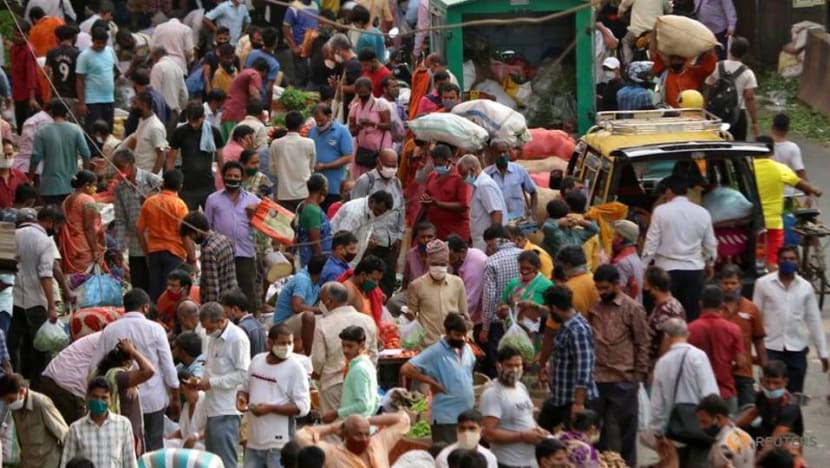commentary Commentary
Commentary: India’s COVID-19 crisis could cause long-lasting economic scars
Even though India’s lockdowns are more targeted this year, significant economic losses remain likely, especially if subsequent waves of the infection continue to burden healthcare infrastructure, says economist Charu Chanana.

A COVID-19 patient on oxygen support is brought to the Rajiv Gandhi General Hospital in Chennai, India, Monday, May 17, 2021. (AP Photo/R. Parthibhan)
SINGAPORE: India’s devastating rise in COVID-19 case numbers and fatalities is proving to be a full-blown tragedy.
Apart from the disastrous impact on lives and livelihoods, the restrictions imposed across the country will greatly impact the economy, with long-lasting scars on the labour market.
An increasing number of states have announced lockdowns in one form or another. Uttar Pradesh has imposed a statewide curfew. West Bengal has introduced a night curfew to go along with the lockdown.
Others like Delhi, have ceased metro transportation services but have allowed some essential services to carry on.
READ: Commentary: Some pain even as Singapore rises to the challenge of tighter COVID-19 measures
More states could see tighter restrictions as the outbreak spreads. While cities like Mumbai and Delhi show signs of peaking, the southern states and rural areas are seeing new surges.
Mobility indicators from Google and Apple show the second wave is starting to bite into economic recovery.
The Indian economy was estimated to have shrunk by 8 per cent last year - its worst performance since independence. Last year’s national lockdown also took a heavy toll on the informal sector.
READ: Commentary: Is Modi already being made to pay for India’s COVID-19 crisis?
While the economic losses this year are not expected to be as steep as last year, the drag is likely to be significant, with further downside risks if subsequent waves of the infection continue to burden healthcare infrastructure.
So far, data collected reflects a mixed trend, with the Goods and Services Tax (GST) collections touching a record high in April but likely to soften in May.
On the other hand, the unemployment rate has ticked up to 8 per cent in April from 6.5 per cent in March, while the labour participation rate has declined further month-on-month, according to the Centre for Monitoring Indian Economy.
The declines in power demand and railway freight have, however, been less severe than last year.
DISMAL VACCINATION STRATEGY
India cannot let its guard down, especially because the pace of vaccinations has been so sluggish.
Initial vaccine rollout has been slow and marked by public scepticism over the Oxford-AstraZeneca vaccine and lack of disclosure about an Indian-developed dose.
READ: Commentary: India’s second COVID-19 wave threatens global supplies of vaccines
The vaccination programme has lagged targets, with supply compounding problems. Daily vaccination rates have been stuck at between 2 million to 2.5 million.
Even if that can be increased to 4 million to 6 million if supplies are ramped up, India can only fully inoculate only 25 per cent to 40 per cent of the population by year-end.

Worse, India has relied mostly on domestic production of the vaccine compared to the other big economies.
But closures owing to lockdowns have led to a shortfall in vaccine doses. Many states have had to close vaccinations for the 18 to 45 age group recently after inoculations for this bracket started on May 1.
The possibility of a worse third wave and the need for annual booster doses against a mutating virus means that demand could continue to outpace supply of vaccines.
READ: Commentary: Indonesia’s vaccine campaign needs serious help to accelerate
The high infection rate as recovering patients gain antibodies could suggest some form of herd immunity, but there is little substitute for vigilance. Global examples too show re-infection is a possibility.
Meanwhile, vaccine pricing has shot up in an attempt to liberalise procurement. Manufacturers have been allowed to sell 50 per cent of the produce directly to states, corporates and private hospitals.
At private hospitals, a single dose can now cost up to 1,500 rupees (US$20), almost six times the original price, which will impose hurdles for vaccinating rural India, where disposable incomes are significantly lower.
ECONOMIC CHAOS TO LEAVE SOME SCARS
India’s consumption saw a quick return to normalcy after the first wave, owing to pent-up demand and festive shopping.
Yet hesitancy over spending may last longer this time around, given the severe impact on lives and livelihoods.

Favourable base effects from last year will make the year-on-year numbers for the fiscal first quarter (April-June) GDP growth look promising. But much depends on when the virus peaks, and even the most optimistic projections will see a sequential decline in the current quarter.
Growth in the second half is likely if the virus peaks by May. The economy can reopen sometime over July to August if cases begin to taper.
READ: Commentary: My harrowing brush with COVID-19 in New Delhi as India is ravaged
But if this virus resurgence remains out of control, we will see longer-lasting scars in the labour market and a drag on India’s potential output.
Consumption spending will take a medium-term hit. Most casualties have been in the adult population, many of whom were likely the sole breadwinners for their families. A disproportionate impact can also be expected on India’s informal sector, which constitutes the bulk of the economy.
The post-pandemic era will also amplify pre-COVID structural headwinds leaving stressed corporate balance sheets and banks with more non-performing assets.
Hence, an investment-led recovery may remain elusive as well, unless structural reforms are prioritised.
GLOBAL REPERCUSSIONS WILL BE MATERIAL
India’s COVID-19 crisis is not only proving to be tough for the domestic economy, it is also likely to create multi-dimensional drags for parts of the global economy and foreign relations.
Variants first detected in India have spread to the global economy.

Even as trade continues, many countries are likely to keep their borders shut to passenger commute, particularly to India, for a prolonged period unless it can get its act together.
The greatest impact will come as India’s migrant labour, key to construction and services industries in the Middle East and in Southeast Asia, have been repatriated.
With borders now closed and limited visibility on when these might open again, labour flows are likely to remain closed or minimal, sparking labour supply shortages in many countries.
India has also stopped exports of vaccines and life-saving drugs, leading to delays in reaching herd immunity, especially for low-income countries.
POLICY MISSTEPS MUST BE AVOIDED
Although the need for immediate spending support remains tilted toward sustenance through cash handouts and easy credit, the pandemic has opened opportunities for investments by the Indian government and the public sector that can take the economy on a high growth path again.
Healthcare investments and support to contact-intensive sectors remain the priority for the next few years, while advancements in digital and e-commerce are also needed.
READ: Commentary: Deep-rooted issues at heart of India's COVID-19 crisis
For now, rating agencies remain optimistic about India’s post-COVID rebound. They see it as being delayed, not denied.
But there is a need to remain watchful as two of the three major agencies - Fitch and Moody’s - have issued a negative outlook on India, and India’s credit rating stands just above investment grade.
Charu Chanana is Lead Economist, Asia, at Continuum Economics.















